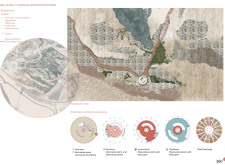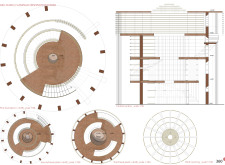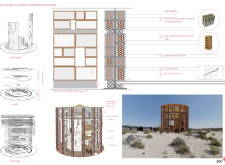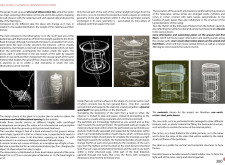5 key facts about this project
Spatial Configuration and Visitor Experience
The tower is designed with a circular footprint, allowing for a seamless flow between different levels. The ground level serves as an introductory space where visitors can engage with informational panels and seating areas. Ascending to the first level, the design includes telescopes for close-up observations, further bridging the connection between the structure and its users. The upper levels provide expansive views of the habitat, allowing visitors to engage intimately with the site.
A distinctive feature of the observation tower is the spiraling pathway that links the various levels. This innovative circulation route mitigates the need for traditional staircases, enhancing the visitor experience with opportunities for exploration and discovery. The implementation of strategically placed skylights also ensures that natural light infiltrates the structure, reducing reliance on artificial lighting and enhancing the sensory experience.
Materiality and Ecological Integration
The material choices reflect an ethos of ecological sensitivity and sustainability. Raw earth bricks are utilized for their low environmental impact and thermal properties, providing insulation and durability. Corten steel elements add structural integrity, while the oxidized surface integrates visual depth that complements the natural landscape. The incorporation of palm leaves not only provides shade but also connects the design to traditional forms of local architecture, creating a synergy between the past and present.
This thoughtful materiality extends to the foundation, where reeds are incorporated to foster biodiversity in the surrounding area. The combination of materials selected for the project underscores the importance of integrating architecture with its environment, emphasizing a sensitive approach to design.
Innovative Architectural Solutions
What sets the Flamingo Observation Tower apart from other observation structures is its focus on experiential learning and interaction with nature. The design invites visitors to engage with their surroundings, fostering an appreciation for wildlife conservation. Each level offers unique vantage points, increasing the variety of sensory experiences available to users. Additionally, the design's documentation, including architectural plans and sections, illustrates the careful consideration of structural integrity and ecological balance.
The project's commitment to sustainability, local materials, and visitor engagement makes it a notable example of contemporary architectural design. To gain deeper insights into the architectural ideas and structural components that define this project, readers are encouraged to explore the project presentation for additional details on architectural designs and sections.


























